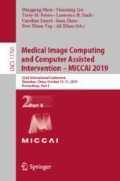Abstract
2D echocardiography (echo) is the most widely used imaging technique to identify cardiac disease. In addition to anatomical variability in patients, the quality of acquired echo image can vary significantly depending on the ultrasound (US) machine and the experience level of the operator, where a poor image quality can affect the diagnosis. This variability can also result in reduced performance of machine learning models trained on these data. With the recent advances in generative adversarial networks (GAN), we demonstrate that it is possible to transfer the image quality of echo images to a user-defined quality level with the use of a multi-domain transfer approach referred as StarGAN. The proposed quality transfer StarGAN (QT-StarGAN) requires no pairs of low-and high-quality echo images and incorporates the temporal information of echo images during the training phase. We evaluate the proposed approach using 16,612 echo cine series obtained from 3,157 patients. Using a standard echo view classification task, we demonstrate that the accuracy of classification is significantly improved using QT-StarGAN.
Z. Liao, M. H. Jafari and H. Girgis–Joint first authorship.
P. Abolmaesumi and T. Tsang–Joint senior authorship.
Access this chapter
Tax calculation will be finalised at checkout
Purchases are for personal use only
Notes
- 1.
14 standard cardiac views: see the 13 class labels in Fig. 5(b) and due to the extreme similarity, PSAX-{M, PM} views are combined as one class. This dataset was collected from Vancouver General Hospital PACS system, under the approvals from the institutional Medical Research Ethics Board and the Information Privacy Office.
References
Abdi, A.H., et al.: Quality assessment of echocardiographic cine using recurrent neural networks: feasibility on five standard view planes. In: Descoteaux, M., Maier-Hein, L., Franz, A., Jannin, P., Collins, D.L., Duchesne, S. (eds.) MICCAI 2017. LNCS, vol. 10435, pp. 302–310. Springer, Cham (2017). https://doi.org/10.1007/978-3-319-66179-7_35
Alexander, D.C., et al.: Image quality transfer and applications in diffusion MRI. NeuroImage 152, 283–298 (2017)
Arjovsky, M., et al.: Wasserstein generative adversarial networks. In: ICML, pp. 214–223 (2017)
Choi, Y., et al.: Stargan: unified generative adversarial networks for multi-domain image-to-image translation. In: IEEE CVPR, pp. 8789–8797 (2018)
Coupé, P., et al.: Nonlocal means-based speckle filtering for ultrasound images. IEEE TIP 18(10), 2221–2229 (2009)
Gaudet, J., et al.: Focused critical care echocardiography: development and evaluation of an image acquisition assessment tool. Crit. Care Med. 44(6), e329–e335 (2016)
Goodfellow, I., et al.: Generative adversarial nets. In: NIPS, pp. 2672–2680 (2014)
Gulrajani, I., et al.: Improved training of wasserstein gans. In: NIPS, pp. 5767–5777 (2017)
He, K., et al.: Deep residual learning for image recognition. In: CVPR, pp. 770–778 (2016)
Hochreiter, S., Schmidhuber, J.: Long short-term memory. Neural Comput. 9(8), 1735–1780 (1997)
Huang, G., et al.: Densely connected convolutional networks. In: IEEE CVPR, vol. 1–2, p. 3 (2017)
Isola, P., et al.: Image-to-image translation with conditional adversarial networks. In: IEEE CVPR, pp. 1125–1134 (2017)
Kang, E., et al.: A deep CNN using directional wavelets for low-dose X-ray CT reconstruction. Med. Phys. 44(10), 360–375 (2017)
Kendall, A., Gal, Y.: What uncertainties do we need in Bayesian deep learning for computer vision? In: NIPS, pp. 5574–5584 (2017)
Kim, T., et al.: Learning to discover cross-domain relations with generative adversarial networks. In: ICML, pp. 1857–1865. JMLR. org (2017).
Nix, D.A., Weigend, A.S.: Estimating the mean and variance of the target probability distribution. In: Neural Networks, vol. 1, pp. 55–60. IEEE (1994)
Ronneberger, O., Fischer, P., Brox, T.: U-Net: convolutional networks for biomedical image segmentation. In: Navab, N., Hornegger, J., Wells, W.M., Frangi, A.F. (eds.) MICCAI 2015. LNCS, vol. 9351, pp. 234–241. Springer, Cham (2015). https://doi.org/10.1007/978-3-319-24574-4_28
Simonyan, K., Zisserman, A.: Very deep convolutional networks for large-scale image recognition. In: ICLR, pp. 1–14 (2015)
Tsantis, S., et al.: Multiresolution edge detection using enhanced fuzzy c-means clustering for ultrasound image speckle reduction. Medical Physics 41(7), 72903-1-11 (2014)
Van Woudenberg, N., et al.: Quantitative echocardiography: real-time quality estimation and view classification implemented on a mobile android device. In: Stoyanov, D., et al. (eds.) POCUS/BIVPCS/CuRIOUS/CPM -2018. LNCS, vol. 11042, pp. 74–81. Springer, Cham (2018). https://doi.org/10.1007/978-3-030-01045-4_9
Wu, L., et al.: FUIQA: fetal ultrasound image quality assessment with deep convolutional networks. IEEE Trans. Cybern. 47(5), 1336–1349 (2017)
Zhang, J., et al.: Fully automated echocardiogram interpretation in clinical practice: feasibility and diagnostic accuracy. Circulation 138(16), 1623–1635 (2018)
Zhu, J.Y., et al.: Unpaired image-to-image translation using cycle-consistent adversarial networks. In: IEEE ICCV, pp. 2223–2232 (2017)
Zuiderveld, K.: Contrast limited adaptive histogram equalization. In: Graphics Gems IV, pp. 474–485. Academic Press Professional Inc. (1994)
Acknowledgements
This work is supported in part by the Canadian Institutes of Health Research (CIHR) and in part by the Natural Sciences and Engineering Research Council of Canada (NSERC). The authors would like to acknowledge the support provided by Dale Hawley and the Vancouver Coastal Health in providing us with the anonymized, de-identified data.
Author information
Authors and Affiliations
Corresponding author
Editor information
Editors and Affiliations
Rights and permissions
Copyright information
© 2019 Springer Nature Switzerland AG
About this paper
Cite this paper
Liao, Z. et al. (2019). Echocardiography View Classification Using Quality Transfer Star Generative Adversarial Networks. In: Shen, D., et al. Medical Image Computing and Computer Assisted Intervention – MICCAI 2019. MICCAI 2019. Lecture Notes in Computer Science(), vol 11765. Springer, Cham. https://doi.org/10.1007/978-3-030-32245-8_76
Download citation
DOI: https://doi.org/10.1007/978-3-030-32245-8_76
Published:
Publisher Name: Springer, Cham
Print ISBN: 978-3-030-32244-1
Online ISBN: 978-3-030-32245-8
eBook Packages: Computer ScienceComputer Science (R0)


